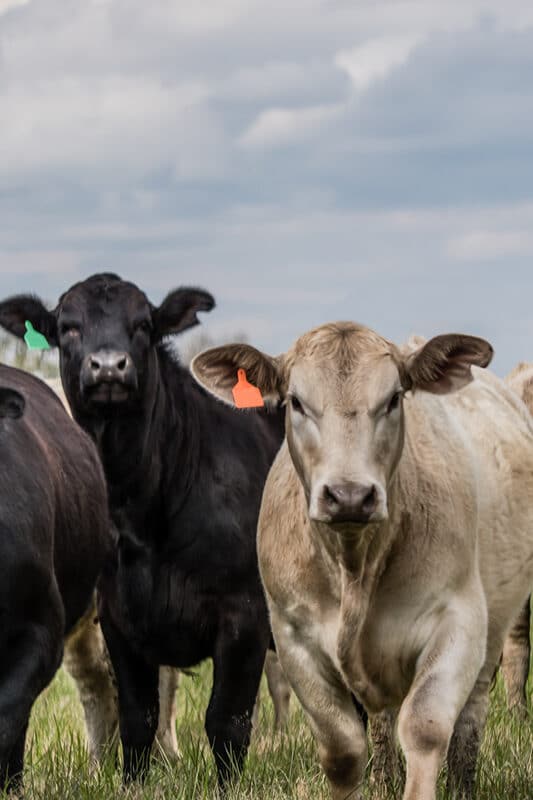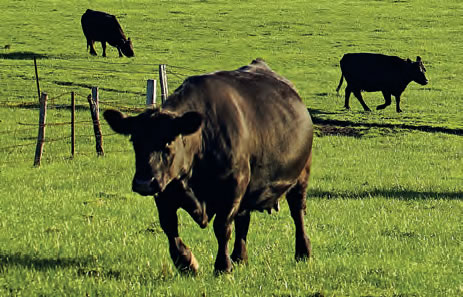
RumenWorks Nutrition
Bloat Assist Lick
- May Aid in reducing the risk of bloat
- Waterproof
- Improves Feed Conversion
- Accelerates Production Gains
- Includes: Elanco Rumensin™
Reach out to livestock nutritionist Ross Gibson on 0447 971 836 for more information about our range of products.
A Useful Aid in the Management of Bloat
The physical structure of the ruminant (sheep and cattle) digestive system places their main site of digestion right at the upper most section of the gastrointestinal tract.
This initial compartment is the large muscular bag known as the rumen. The role of the rumen is to provide an optimal habitat for microbial populations to ferment the feed eaten by the animal. Consequently, the by-products of fermentation become an energy and protein resource for the animal, potentially constituting over 75% of all the animals protein and energy requirements.
This fermentation process relies upon a series of variables to be constant to get maximum efficiency and benefit from the process. Dramatic changes to diet, or certain types of feed can have a detrimental effect on this fermentation process, that can cause death from excessive gas build up know as bloat.
If fermentation becomes ‘excited’ by high quality feed that contains levels of fermentable materials that spike the fermentation process, excessive gas may be produced.
Normally the animal relies upon a process of burping to expel these gasses, and this process is driven by strong, controlled muscle contractions. However, the characteristics of the feeds that excite the fermentation process, tend to have chemical compositions that inhibit the correct muscle control required for the expulsion of these gases.
One of these major inhibitors is Potassium (see Tech NoteGrass Tetany). The ingestion of certain types of feed (such as legumes) creates a style of fermentation that produces a foamy mass in the rumen. This foam traps the gas that is naturally produced, and it becomes harder for the animal to expel this excessive gas. Management of bloat can be difficult as it can happen very suddenly, but there are several things that can be done to proactively reduce the risks.
Feeding:
In high pressure situations such as Bloat and Grass Tetany the product must be continuously available. There must be adequate troughing. 1 trough to 25 head for cattle. Spread the troughs around the paddock near watering points.
Dose Rate:
Cattle consumption rates can vary due to individual conditions on property, and in the animal. As a guide to attain protection against Grass Tetany, the following dose rates should be used as a base point.
| Dose Rate | Cattle |
| 200kg: | 50g/day |
| 400kg: | 100g/day |
| 600kg: | 150g/day |
Supply Hay:
The process of chewing helps maintain a stable “fermentation vat” in the rumen. Chewing produces saliva, and saliva helps maintain the correct pH of the rumen. Hay also substitutes the amount of rumen challenging feed being consumed.
Supply Supplements:
As the feedstuffs that cause bloat also generally reduce muscle control, correct supplementation is essential. The rate and strength of rumen contractions that help expel the excessive gas, and break up the build up of foam, is compromised due to an unbalanced nutrient profile. Supplementing magnesium and fermentable starches that help stabilise muscle control, strength and style of fermentation reduces the risk of bloat.
Producers should also consider using bloat oil in water troughs in bloat situations. Seek specific advice on use of this product from your preferred rural merchant.
The inclusion of other additives such as Rumensin (As contained in many of the RumenWorks Green Feed Range), can significantly decrease the risk of bloat. Studies have shown a 73% decrease in gas formation by supplying Rumensin™. (Katz MPet.al).
Clostridial Vaccine:
Enterotoxaemia (pulpy kidney) goes hand in hand with high-risk bloat situations. Up to date vaccination programs are essential to overall rumen and animal health.
References: J Anim Sci.1986 Oct;63(4):1246-57. Ruminal changes in monensin-and lasalocid-fed cattle grazing bloat-provocative alfalfa pasture.
Katz MP, Nagaraja TG, Fina LR
Typical Bloat Assist Lick Macro Nutrients:
| Macro Nutrients | g/kg |
| Calcium | 130 |
| Magnesium | 99 |
| Phosphorus | 18.7 |
| Sulphur | 47.4 |
| Sodium | 82.68 |
| Carbohydrates | 174.2 |
| Cattle Dose Rate: | 100g/hd/day |
| Sheep Dose Rate: | 30g/hd/day |

There is no doubt our lambs benefit with extra weight gains using RumenWorks Bloat Feed Lick. We find using the RumenWorks product helps us get our lambs to market that couple of weeks quicker, which can make a big difference at the end of the lamb season.

